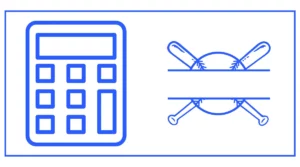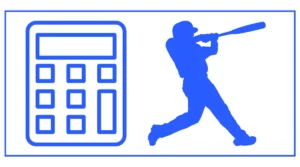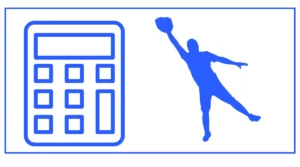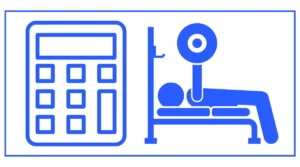On Base Percentage Calculator
Do you want to calculate your on base percentage?
In case you don’t know, OBP measures how often a batter gets on base per time at bat. Hits, walks, and being hit by a pitch are counted as times on base, but errors, fielder’s choices, and dropped third strikes are not.
This on base percentage calculator helps you find your baseball OBP easily.
Enter your number of hits, bases on balls, hits by pitch, at bats, and sacrifice flies to find the on base percentage.
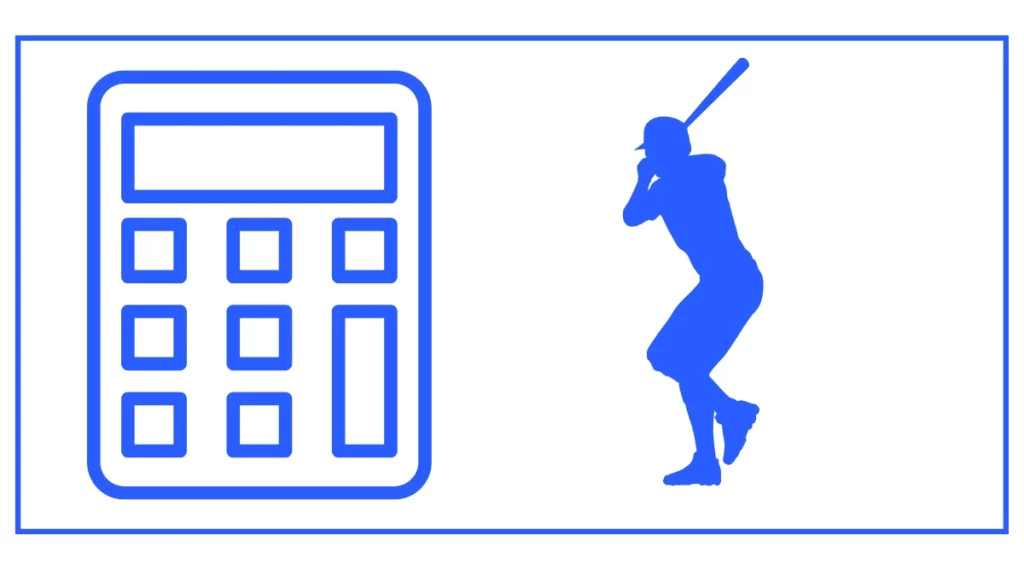
You might want to discover your ERA or winning percentage.
What is Base Percentage in Baseball?
Base percentage, or on-base percentage (OBP), is a crucial statistic in baseball that measures how often a batter reaches base. It’s a more comprehensive measure of a player’s offensive contribution than batting average, as it takes into account not only hits but also walks and times hit by pitch.
The Importance of OBP in Baseball
On-base percentage is considered one of the most significant offensive statistics in baseball. It provides a clearer picture of a batter’s ability to get on base, which is fundamentally what offense in baseball is all about. A high OBP indicates that a player is adept at avoiding outs and creating scoring opportunities for their team.
How to Calculate On-Base Percentage
The formula for calculating on-base percentage is relatively straightforward:
OBP = (Hits + Walks + Hit by Pitch) / (At Bats + Walks + Hit by Pitch + Sacrifice Flies)
Let’s break down each component of this formula:
- Hits: The number of times a batter successfully reaches base by hitting the ball into play and reaching base safely.
- Walks (BB): The number of times a batter is awarded first base due to receiving four balls during an at-bat.
- Hit by Pitch (HBP): The number of times a batter is awarded first base after being hit by a pitched ball.
- At Bats (AB): The number of plate appearances, excluding walks, hits by pitches, sacrifices, and catcher’s interference.
- Sacrifice Flies (SF): The number of times a batter is credited with advancing a runner while making an out on a fly ball.
Using the Base Percentage Calculator
While the formula for OBP is not overly complex, calculating it manually for multiple players or over an extended period can be time-consuming. This is where the base percentage calculator comes in handy.
How the Base Percentage Calculator Works
The base percentage calculator is a simple yet powerful tool that automates the OBP calculation process. Here’s how to use it:
- Input the required statistics: hits, walks, hits by pitch, at bats, and sacrifice flies.
- Click the “Calculate” button.
- The calculator will instantly provide the player’s on-base percentage.
This tool saves time and reduces the chance of calculation errors, making it invaluable for coaches, analysts, and passionate fans alike.
Interpreting OBP
Understanding what constitutes a good OBP is crucial for evaluating player performance. In Major League Baseball, the league average OBP typically hovers around.320 to.330. Here’s a general guideline for interpreting OBP:
- Excellent: .400 and above
- Great:.370 : to.399
- Above Average:.340 : to.369
- Average:.320 : to.339
- Below Average:.300 : to.319
- Poor: Below 300
It’s important to note that these ranges can vary slightly depending on the overall offensive environment of a particular season or era.
The Relationship Between OBP and Other Baseball Statistics
On-base percentage is often considered alongside other key baseball statistics to provide a comprehensive view of a player’s offensive capabilities.
OBP vs. Batting Average
While batting average (BA) has traditionally been the go-to statistic for measuring a hitter’s success, OBP is generally considered a more valuable metric. Batting average only accounts for hits, while OBP includes walks and hit-by-pitch, providing a more complete picture of a batter’s ability to avoid outs.
OBP and Slugging Percentage: OPS
OBP is often combined with slugging percentage to create OPS (On-base Plus Slugging). This statistic aims to give a more rounded view of a player’s offensive value, considering both their ability to get on base and their power hitting.
Historical Perspectives: Great OBP Performers
Throughout baseball history, certain players have stood out for their exceptional on-base percentages. Let’s look at a few notable examples:
- Ted Williams: Known as one of the greatest hitters of all time, Williams holds the all-time career OBP record with .482.
- Barry Bonds: Bonds holds the single-season OBP record with an astounding .609 in 2004.
- Babe Ruth: The legendary slugger maintained a career .474 OBP, second only to Ted Williams.
These players’ extraordinary OBPs demonstrate their exceptional plate discipline and ability to consistently reach base, making them some of the most valuable offensive players in baseball history.
Factors Affecting On-Base Percentage
Several factors can influence a player’s on-base percentage:
- Plate Discipline: Batters with good plate discipline can recognize pitches outside the strike zone, leading to more walks and a higher OBP.
- Contact Skills: Players who make consistent contact are more likely to get hits, boosting their OBP.
- Speed: Faster players may have a slight OBP advantage as they’re more likely to beat out infield hits.
- Power: Ironically, power hitters often have high OBPs because pitchers are more likely to pitch around them, resulting in more walks.
- Batting Order Position: Leadoff hitters typically have higher OBPs as their role is to get on base for the power hitters behind them.
The Evolution of OBP in Baseball Analytics
The importance of on-base percentage has grown significantly in recent decades, particularly with the rise of sabermetrics and advanced baseball analytics.
Moneyball and OBP
The book “Moneyball” by Michael Lewis, later adapted into a popular film, highlighted how the Oakland Athletics used undervalued statistics like OBP to build a competitive team on a budget. This brought OBP into the mainstream and changed how many teams evaluated players.
Modern Use of OBP in Team Strategy
Today, many teams place a high value on OBP when constructing their lineups and making personnel decisions. The ability to get on base consistently is recognized as a crucial component of offensive success.
Using the Base Percentage Calculator for Player Comparison
The base percentage calculator can be a valuable tool for comparing players’ offensive contributions. By inputting the statistics for different players, you can quickly see how they stack up in terms of OBP.
Example Comparison
Let’s use our base percentage calculator to compare two hypothetical players:
Player A:
- Hits: 150
- Walks: 60
- Hit by Pitch: 5
- At Bats: 550
- Sacrifice Flies: 3
Player B:
- Hits: 170
- Walks: 40
- Hit by Pitch: 2
- At Bats: 600
- Sacrifice Flies: 5
Using the calculator, we find:
- Player A’s OBP: .349
- Player B’s OBP: .332
Despite Player B having more hits, Player A’s superior walk rate results in a higher OBP, potentially making them more valuable offensively.
Limitations of On-Base Percentage
While OBP is a valuable statistic, it’s important to recognize its limitations:
- It doesn’t account for the quality of hits (singles vs. extra-base hits).
- It treats walks and hits equally, which may not always reflect their true value in game situations.
- It doesn’t consider stolen bases or other base-running contributions.
These limitations are why OBP is often used in conjunction with other statistics to provide a more complete picture of a player’s offensive value.
Frequently Asked Questions
Why is OBP considered more valuable than batting average?
OBP provides a more comprehensive view of a player’s ability to avoid outs by including walks and hits by pitches, not just hits.
How often is OBP updated during a season?
A: In professional baseball, OBP is typically updated daily during the season.
Can OBP be used in other baseball-like sports?
Yes, OBP can be calculated for similar sports like softball, using the same formula.
Are there any situations where a lower OBP might be acceptable?
While a higher OBP is generally better, power hitters might have slightly lower OBPs but compensate with more extra-base hits.
How accurate is the base percentage calculator?
The calculator uses the official MLB formula for OBP, making it highly accurate when provided with correct input data.
Understanding and calculating on-base percentage is crucial for anyone looking to gain a deeper appreciation of baseball statistics. The base percentage calculator simplifies this process, allowing fans, coaches, and analysts to quickly evaluate and compare players’ offensive contributions.
By considering OBP alongside other key statistics, we can develop a more nuanced and accurate picture of a player’s overall value to their team.
